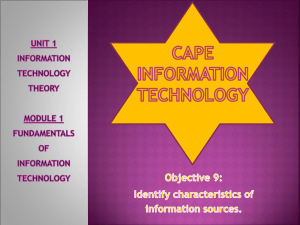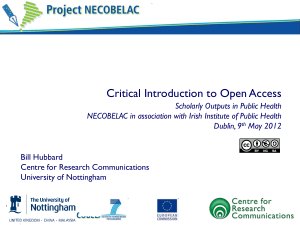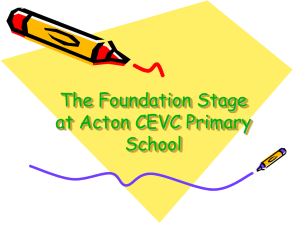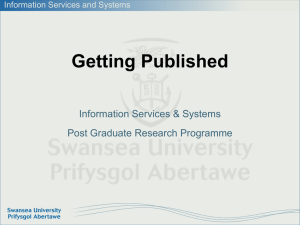PPT - Florida State University
advertisement
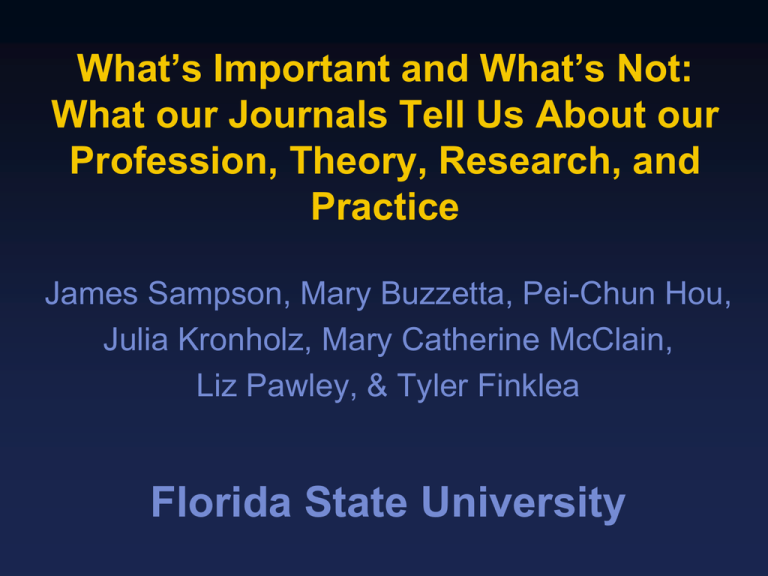
What’s Important and What’s Not: What our Journals Tell Us About our Profession, Theory, Research, and Practice James Sampson, Mary Buzzetta, Pei-Chun Hou, Julia Kronholz, Mary Catherine McClain, Liz Pawley, & Tyler Finklea Florida State University Presentation Outline • • • • • • • • Introduction Prior annual reviews Content analyses of journal articles Theory, research, practice Methodology Results and discussion Implications and limitations Conclusion Prior Annual Reviews • • • • • • • • Savickas, M. L. (1989) Spokane, A. R., & Hawks, B. K. (1990) Cook, E. (1991) Jepsen, D. A. (1992) Salomone, P. R. (1993) Subich, L. (1994) Walsh, W., & Srsic, C. (1995) Stoltz-Loike, M. (1996) Prior Annual Reviews • • • • • • • Niles, S. G. (1997) Swanson, J. L., & Parcover, J. A. (1998) Young, R. A., & Chen, C. P. (1999) Arbona, C. (2000) Luzzo, D., & MacGregor, M. (2001) Whiston, S. C., & Brecheisen, B. K. (2002) Flores, L. Y., Scott, A. B., Yu-Wei, W., Yakushko, O., McCloskey, C. M., Spencer, K. G., & Logan, S. A. (2003) Prior Annual Reviews • • • • • • • • Dagley, J. C., & Salter, S. K. (2004) Guindon, M. H., & Richmond, L. J. (2005) Harrington, T. F., & Harrigan, T. A. (2006) Tien, T. (2007) Chope, R. C. (2008) Patton, W., & McIlveen, P. (2009) Hartung, P. J. (2010) Creager, M. (2011) Prior Annual Reviews • Erford, B. T., & Crockett, S. A. (2012) • Bikos, L. H., Dykhouse, E. C., Boutin, S. K., Gowen, M. J., & Rodney, H. E. (2013) • Sampson, J. P., Jr., Hou, P. C., Kronholz, J. F., Dozier, V. C., McClain, M. C., Buzzetta, M., Pawley, E. K., Finklea, J. T., Peterson, G. W., Lenz, J. G., Reardon, R. C., Osborn, D. S., Hayden, S. C. W., Colvin, G. P., & Kennelly, E. L. (2014) Content Analyses of Journal Articles • Four basic forms: – Analyzes the content of multiple journals in a given year – Analyzes the content of a single journal over an extended period of time – Compares the content of two journals over an extended period of time – Analyzes journal content related to a specific topic for one journal or multiple journals Content Analyses from Career Journals • Career development journal reviews – Five content analyses of CDQ, JVB, and JCA • Life-span career development/perspectives, career development interventions, career assessment/assessment of vocational behavior, person-environment fit/Holland’s theory, and decision making Content Analyses from CDQ Annual Reviews • Three trends – Career theory, career assessment, and gender – Life-career development, self-efficacy, worklife/family balance, career transitions, and disability – Professional issues/development, international students, mentoring, sexual orientation, job satisfaction, career maturity/adaptability, wellbeing, social justice, emotional intelligence, calling, social class, and immigration status Integrating Theory, Research, and Practice Literature on Integrating Theory, Research, and Practice • Influence of theory on research • Influence of theory on practice • Influence of research on practice Influence of Theory on Research • Career theory provides a foundation for the study of vocational behavior and career development , and for examining evidencebased practice • Karr and Lawson (2005) found that a theory or model was used to guide research in only 43% of the data-based studies they reviewed Influence of Theory on Practice • Practitioners can link theory-based concepts with client needs to better select career interventions • The potential contribution of theory to practice may be somewhat limited Influence of Research on Practice • Research is also a fundamental tool in creating new career resources and services • Murray (2009) noted that a chasm exists between researchers and practitioners Methodology • Selection of journal articles included in the analysis – Total of 357 articles from 24 different journals • Development of a schema for career constructs – Total of 458 concepts were included in all four levels of the final schema – Used to answer research question #1 Methodology • Journals included in the analyses: – – – – – – – The Career Development Quarterly Career Planning and Adult Development Journal Journal of Vocational Behavior Journal of Career Assessment Journal of Career Development Journal of Employment Counseling International Journal for Educational & Vocational Guidance Methodology • Journals included in the analyses: • • • • • • • • Adultspan Journal American Psychologist British Journal of Guidance and Counselling Journal of Applied Psychology Journal of Counseling & Development Journal of Counseling Psychology Journal of Organizational Behavior Measurement and Evaluation in Counseling and Development • Australian Journal of Career Development • Rehabilitation Counseling Bulletin Methodology • Journals included in the analyses: • The Counseling Psychologist • The Professional Counselor • Journal of the National Institute for Career Education and Counselling • The Canadian Journal of Career Development • Canadian Journal of Counseling & Psychotherapy • International Journal for the Advancement of Counselling • South African Journal of Industrial Psychology Methodology • Created operational definitions for key terms – Used to answer research questions #2-4 • Coding process – Mean number of content terms coded per article was 4.57 (SD = 2.38) • SPSS – Articles in rows, and content topics and theory/research/practice variables in columns Research Question #1 • What content topics were included in career development articles published in refereed journals in 2013? – What content topics appear most frequently in the journal literature? – What content topics appear to be underrepresented in the journal literature? Results – Research Question #1 • Five general themes: – Personal characteristics and state of being (578 times) – Delivery of career interventions (230 times) – External factors influencing the individual (126 times) – Theory (114 times) – Occupational, educational, or employment options (37 times) Results – Research Question #1 • Content topics underrepresented in the literature: – – – – – – – – – – – Accountability Aptitude Career library Creativity Glass ceiling Information classification systems Learning styles Life-long learning Mock interviews Sexual harassment Work-to-school transition Discussion – Research Question #1 • Examples of content topics that have remained constant over time: – RIASEC and life span/life space career theories – The design and use of career assessments – Individual characteristics – The nature and process of decision making – The centrality of employment as an outcome Discussion – Research Question #1 – – – – – Personal characteristics and state of being = 53.27% Delivery of career interventions = 21.20% External factors influencing the individual = 11.61% Theory = 10.51% Occupational, educational, or employment options = 3.41% Research Question #2 • To what extent are theory, research, and practice integrated in career development articles published in refereed journals in 2013? Results – Research Question #2 • What is the overall proportion of the literature that includes theory, research, and practice? – Theory = 176 (30.72%) – Research = 266 (46.42%) – Practice = 131 (22.86%) Results – Research Question #2 • To what extent are one or more theories included in research articles? – 145 articles which included both theory and research – Represented 54.51% of the total 266 articles coded as research Results – Research Question #2 • To what extent are one or more theories included in practice articles? – 51 articles which included both theory and practice – Represented 38.93% of the total 131 articles coded as practice Results – Research Question #2 • To what extent is research included in practice articles? – 51 articles which included both research and practice – Represented 38.93% of the total 131 articles coded as practice Discussion – Research Question #2 • Integration happens 44.12% of the time – Enhances quality and utility of the literature – Requires a systematic approach – A rough estimate of a desirable level of integration would be an average of 75% Research Question #3 • What variation exists in the characteristics of career development articles published in refereed journals in 2013? 31 Results – Research Question #3 • What are the most common theories included in the literature? – – – – – – Social Cognitive-Career Theory (n = 35) Career Construction-Life Design Theory (n = 19) RIASEC Theory (n =17) Big Five Factor Theory (n = 11) Job Demands-Resources Model (n =8) Life Span/Life Space Theory (n =8) Results – Research Question #3 • When theories are included in the literature, are these theories presented as a single theory or multiple theories? – Average number of theories per article was 1.27 (SD = 0.53) Results – Research Question #3 • To what extent do research articles focus on the study of vocational behavior versus evidence-based practice? – 93% (n = 247) involved the study of vocational behavior – 7% (n = 19) involved the examination of evidence-based practice Results – Research Question #3 • To what extent do research articles use quantitative, qualitative, and mixed methods? – 82% (n = 217) were quantitative – 14% (n = 37) were qualitative – 4% (n = 12) were mixed methods Results – Research Question #3 • What is the relative proportion of articles pertaining to career resources and career services? – Career resources = 24% (n = 88) – Career services = 19% (n = 67) – Both career resources and career services = 11% (n = 38) – Neither career resources or career services = 46% (n = 164) Discussion – Research Question #3 • The use of multiple theoretical perspectives • Lack of evidence-based practice in our field • Topic of accountability Discussion – Research Question #3 • Assessment of career intervention learning outcomes • Vast majority of resources included in articles were career assessments Research Question #4 • What variation exists in the content included in theory, research, and practice articles? Results – Research Question #4 • To what extent are theory, research, and practice included in articles categorized as career resources and career services? Results – Research Question #4 – Career resources • Theory = 30% (n = 42) • Research = 46% (n = 65) • Practice = 24% (n = 34) – Career services • Theory = 21% (n = 21) • Research = 37% (n = 37) • Practice = 42% (n = 43) Results – Research Question #4 • What are the most common theories used in research articles versus practice articles? Results – Research Question #4 – Research articles • • • • • • • • Social Cognitive Career Theory (22) RIASEC Theory (16) Career Construction-Life Design Theory (15) Big Five Personality Factor Theory (10) Job Demands-Resources Model (8) Self-Determination Theory (7) Life Span Life Space Theory (4) Relational Theory of Working (4) Results – Research Question #4 – Practice articles • • • • • • • • Social Cognitive Career Theory (13) Career Construction-Life Design Theory (7) RIASEC Theory (6) Theory of Circumscription and Compromise (6) Cognitive Information Processing Theory (3) Life Span Life Space Theory (3) Social Learning and Happenstance Theory (3) Latent Deprivation Theory (2) Results – Research Question #4 • What are the most common theories used in research articles categorized as vocational behavior versus evidencebased practice? Results – Research Question #4 • Vocational Behavior – – – – – – – – – Social Cognitive Career Theory (22) RIASEC theory (16) Career Construction-Life Design Theory (15) Big Five Personality Factor Theory (10) Job Demands-Resources Model (8) Relational Theory of Working (4) Conservation of Resources Theory (4) Life Span Life Space Theory (4) Self-Determination Theory (7) Results – Research Question #4 • Evidence-Based Practice – – – – – – – – – Social Cognitive Career Theory (2) Attribution Theory (1) Career Decision-Making Self-efficacy Model (1) Conservation of Resources Theory (1) Expectancy Value Theory (1) Human Capital Theory (1) Latent Deprivation Theory (1) RIASEC Theory (1) Social Learning Theory (1) Results – Research Question #4 • What are the most common content topics in theory, research, practice, and all articles combined? Results – Research Question #4 • Career self-efficacy – All articles (n = 35) – Research articles (n = 31) • Social-Cognitive Career Theory – Theory articles (n = 35) • STEM occupations – Practice articles (n = 18) Discussion – Research Question #4 • Career theories used in research and practice were similar • Popularity of specific theories and the need to explore them in practice • Missed opportunities for integration Implications for Practice • Future topic content • Better integration of theory, research, and practice • Education and training • Journal editorial policy • Content analyses of journal articles Future Topic Content • Topics important at this time in history • Adopt a 60 - 30 - 10 goal • Distinguish between best practices and evidence-based practice • Compare the cost-effectiveness of various career interventions Integration of Theory, Research, and Practice • Increased collaboration among theorists, researchers, and practitioners – External grant funding – Lobby policy makers – Encourage students to use the research literature – More use of case studies – More practitioner engagement in research Education and Training • “Increase the emphasis in counseling methods courses on using research findings as a means of answering real-life problems” (Anderson & Heppner, 1986, p. 152) Journal Editorial Policy • Rebalancing of content related to theory, research, practice, and policy is needed • Special issues or dedicated sections of journals could be used • A need for policy analysis Content Analyses of Journal Articles • Conduct large-scale reviews every five to ten years • Include more diverse types of refereed literature, as well as non-refereed publications Limitations • Special issues of journals • Key words in journals • Terminology Conclusion • The largest proportion of the literature was devoted to research • Opportunities for integration were not often being realized • Unprecedented opportunity to achieve goals Audience Questions For more information: www.career.fsu.edu/techcenter
